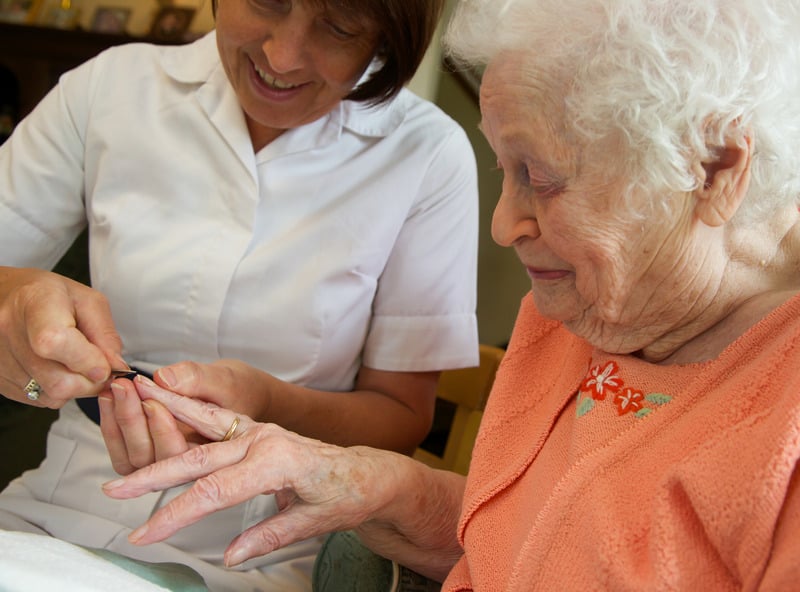Nail care is an important aspect of overall health, especially for elderly individuals. As we age, our nails can become more susceptible to various disorders and conditions. Proper nail care helps maintain good nail health and prevents complications. This article explores the special considerations for nail care in the elderly, providing practical tips and insights.
Importance of Nail Care for the Elderly
Dr. Amy McMichael, a dermatologist, highlights that proper nail care is essential for maintaining good nail health in the elderly, as they are more susceptible to skin and nail disorders (ABC News). As we age, our nails can become thicker, more brittle, and prone to infections. Taking care of our nails can prevent discomfort and improve overall well-being.
Common Nail Problems in the Elderly
1. Ingrown Toenails
Ingrown toenails occur when the edge of a nail grows into the surrounding skin, causing pain and sometimes infection. Regular nail trimming and filing can help prevent ingrown toenails, which can be painful and difficult to treat in seniors, according to Dr. Alexandra Gardner, a podiatrist (Harvard Health Publishing).
Prevention Tips:
- Trim Nails Straight Across: Avoid cutting nails too short or rounding the corners.
- Wear Proper Footwear: Shoes that fit well can prevent pressure on the toes.
- Soak Feet: Soaking feet in warm water can soften nails and make them easier to trim.
2. Fungal Nail Infections
Fungal nail infections, or onychomycosis, are common among elderly individuals. These infections can cause nails to become thick, discolored, and brittle. Prompt treatment with topical or oral antifungal medications is crucial to prevent further spread, notes Dr. Cynthia Bailey, an infectious disease specialist (CDC).
Treatment Options:
- Topical Antifungals: Medications applied directly to the nail.
- Oral Antifungals: Prescription pills that treat the infection from the inside.
- Preventive Measures: Keep feet dry and clean, wear breathable footwear, and avoid sharing nail tools.
3. Nail Discoloration and Thickening
Nail discoloration, thickening, or separation from the nail bed can indicate underlying health conditions such as diabetes or thyroid disorders. These changes should be evaluated by a healthcare professional, as Dr. William Roberts, an internist, advises (Johns Hopkins Medicine).
Signs to Watch For:
- Yellow Nails: Could indicate fungal infections or respiratory issues.
- White Spots: Often harmless but can signal injury or infection.
- Thickened Nails: Common with age but can also be a sign of fungal infection or poor circulation.
Practical Nail Care Tips for the Elderly
Regular Trimming and Filing
Keeping nails trimmed and filed is crucial for preventing complications. Use proper nail clippers and a fine emery board to maintain nail length and smooth edges. For those with difficulty reaching their feet, consider using long-handled clippers or seeking help from a caregiver.
Moisturizing
Dry nails can become brittle and more prone to breaking. Regularly moisturizing nails and cuticles with hand cream or cuticle oil can help maintain their flexibility and health.
Avoiding Harsh Chemicals
Elderly individuals should avoid nail products that contain harsh chemicals, as they can weaken nails and irritate the skin. Opt for gentle, non-toxic nail polishes and removers.
Personal Insights and Stories
From my own experience with elderly family members, regular nail care has proven to be a simple yet effective way to maintain their comfort and health. For instance, my grandmother used to struggle with ingrown toenails until we started trimming her nails more carefully and ensuring she wore properly fitting shoes. This small change significantly improved her comfort and mobility.
Another friend’s elderly father experienced frequent fungal infections due to diabetes. With proper treatment and preventive measures, such as keeping his feet dry and using antifungal sprays, he managed to keep the infections at bay and maintain healthier nails.
Statistics on Nail Health in the Elderly
A cross-sectional study published in the Journal of the American Geriatrics Society found that fungal nail infections are highly prevalent in elderly patients, with risk factors including diabetes, peripheral vascular disease, and impaired mobility. Another study in the British Journal of Dermatology showed that topical application of terbinafine solution was effective in treating fungal nail infections in elderly patients, with a high cure rate and minimal side effects.
Professional Care and When to Seek Help
While at-home nail care is important, professional care may be necessary for managing more complex nail issues. Regular visits to a podiatrist or dermatologist can help address problems like fungal infections, severe ingrown toenails, or nail changes related to underlying health conditions.
When to Seek Professional Help:
- Persistent Pain or Swelling: If you notice persistent pain or swelling around your nails, it’s time to see a healthcare provider.
- Signs of Infection: Redness, warmth, pus, or other signs of infection should be evaluated promptly.
- Sudden Changes in Nail Appearance: Sudden or severe changes in the color, thickness, or shape of your nails can indicate health problems that need medical attention.
Conclusion
Nail care is an essential part of maintaining overall health, especially for the elderly. Regular trimming, moisturizing, and avoiding harsh chemicals can help prevent common nail problems and keep nails healthy. By paying attention to changes in your nails and seeking professional help when needed, you can enjoy healthier, more comfortable nails as you age. Remember, taking care of your nails is an important aspect of self-care that can greatly improve your quality of life.



